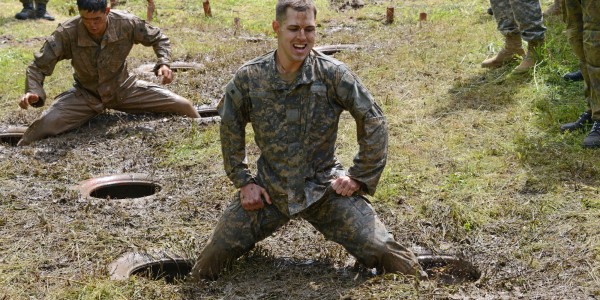

Just about every veteran and service member I know has, at some point, injured themselves. And it was my own injuries that ultimately pushed me into the fitness industry, where I learned fancy terms like “corrective exercise,” “dysfunctional movement patterns,” and my favorite: “the cumulative injury cycle.” I also learned that the most common injuries — tendonitis, stress fractures, muscle strains, etc. — are overuse injuries caused by dysfunctional movement patterns.
When you’re moving your body in ways it was not designed to move, you set yourself up for failure. And even after you’ve healed from an overuse injury, it is very likely that, upon resuming normal activities, you will experience a similar injury down the road. Thus begins the cumulative injury cycle. To prevent that from happening, it is incredibly important to perform corrective exercises, which are routines that encourage the development of optimum movement efficiency.
Here are five corrective exercises that will keep you in the fight.
Related: What It Actually Means To Listen to Your Body »
Mobilize.
Joints need optimum range of motion in order to function properly. Before you start exercising, make sure you take use a foam roll or lacrosse ball and then stretch your tight muscles (always in that order) so they can contract and expand the way healthy muscles should. This will help your body’s natural ability to absorb shock and avoid movement compensations. Basically, an overused muscle won’t be as prone to being overused if you loosen it up. Common muscles that require rolling and stretching are: calves, quads, hamstrings, and TFL (that thing on the side of your hip that’s linked to your IT band and gives you Runner’s Knee when it’s angry).
Movement prep.
Prior to your workout, perform light exercises that will wake up your weaker or more dormant muscles so they can become a part of the equation when you are moving. The most common muscles that need waking up are glutes and deep core muscles, so simple exercises like the plank and pelvic bridges are a great way to create the right amount of engagement without tiring you out. Also, since the military makes runners out of all of us, I highly recommend waking up the feet and calves by doing several sets of calf raises. For those who are especially well-balanced, single legged calf raises are even better.
Know your limits.
We’ve all pushed ourselves too hard at times, and that’s totally fine, but to regularly train way past your normal limit is neither intelligent nor healthy. If you haven’t ran more than 2 miles since the last time the Spice Girls were on tour, suddenly going for a 5, 6, or 10 mile run is really just knocking on injury’s door. Your body is highly adaptable, but it can only work so fast. With running in particular, you want to avoid sudden large increases in length and intensity because of its highly repetitive nature (steps equals repetitions). When overexerting your body, it is very easy for muscular compensations to occur, which can then cause strained calves, quads, hamstrings, and even stress fractures.
Practice mindfulness.
Being conscious and aware of your body and its interactions with its environment is a critical skill that everyone needs, regardless of what you are doing. It is especially important for members of the military because of the high physical and mental demands of the job. The key to creating and maintaining our bodily awareness is to move consciously. During PT, keep your mind in the present instead of trying to zone out, and try to feel the different muscles that are being used as you are performing the exercises. Do a mental body scan and ask yourself, “How does my neck feel? Am I breathing well? Are my shoulders/elbows/knees sounding like Rice Krispies after milk has been added?” You will never be able to prevent injury if you don’t feel the subtle warnings that your body is giving off.
Do your homework.
The truth is, the most effective way to minimize risks of injury is to work on your body’s issues on your own time. First, learn proper form for all of the exercises you intend to perform. For example: ideal running form actually requires a mid-foot strike. Second, learn where you’re weak: Can you stand on one leg? Can you only do push ups with your hips sagging? When you try to tighten your glutes, does it feel like there is barely a blip on the radar? Don’t be afraid to do an honest assessment of your body in order to gauge where you may need a little extra work. Third, mobilize daily, not just before PT. As I said before, your body is highly adaptable, but it does require some time, so be sure to develop a good rolling and stretching routine for daily use. As your mobility improves, you can taper off the frequency as needed. Finally, learn your own body. Some people can drink Mountain Dew, smoke a pack of cigarettes a day, eat nothing but sugar, and still run five miles faster than a 19-year-old. Unfortunately, these people are exceptions and not the rule. Know what your body feels like on good days and bad days, and adjust fire from there.
